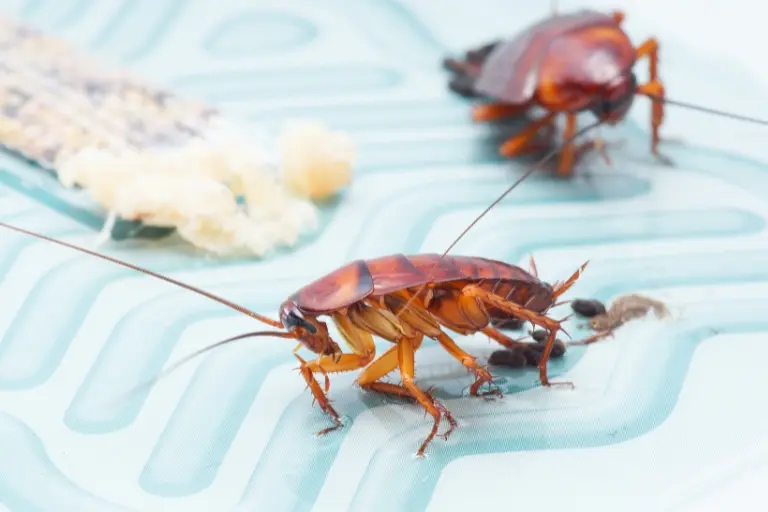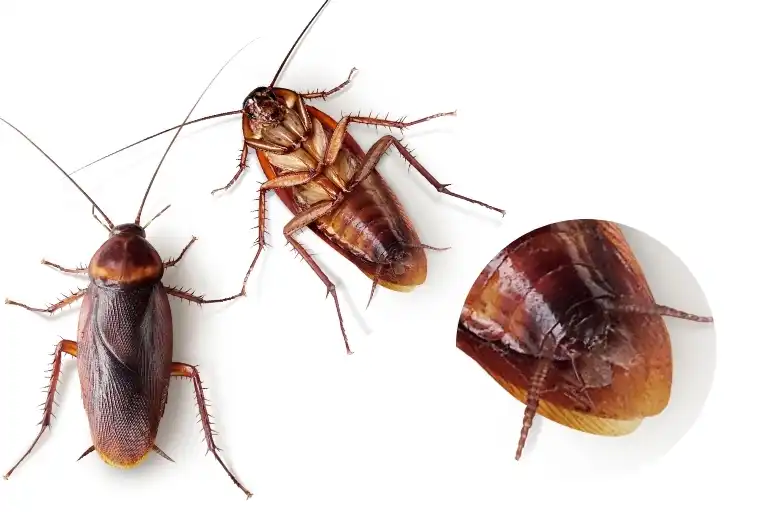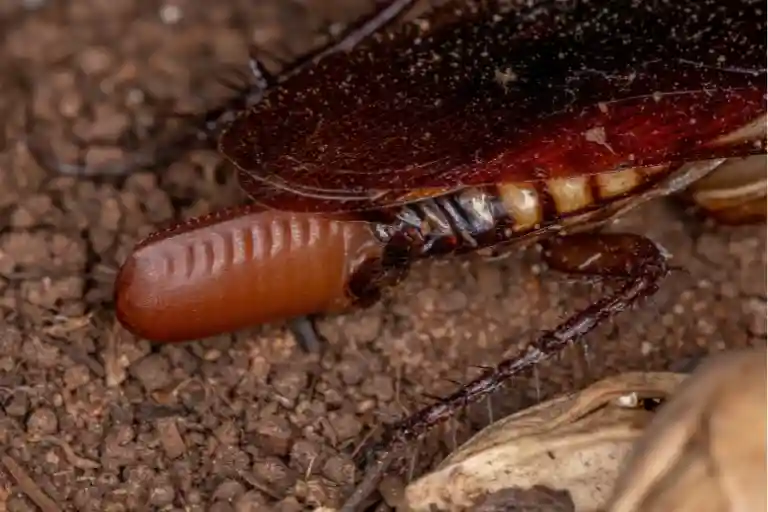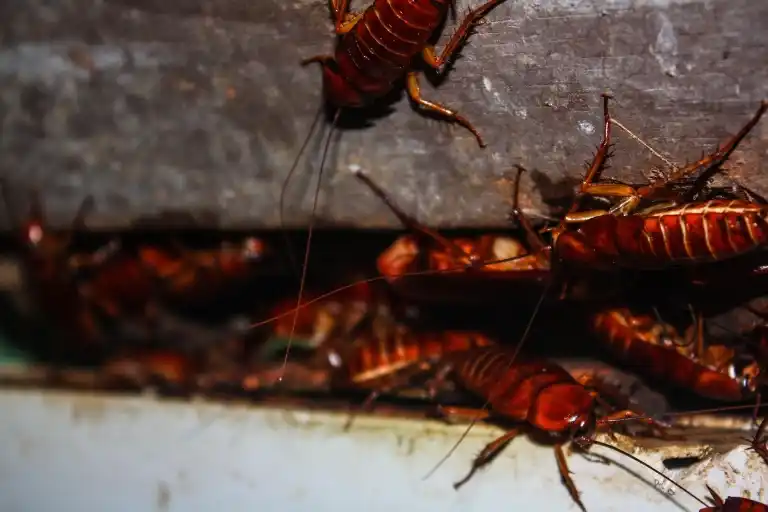Cockroaches reproduce by mating, with the females producing egg cases called oothecae. Each ootheca contains multiple eggs that develop into nymphs after hatching.
Cockroaches are notorious for their resilience and prolific reproduction.
Understanding how these insects proliferate can provide insights into their persistence and the challenges in controlling infestations.
Female cockroaches attract males using pheromones to initiate the mating process. After mating, they produce an ootheca that can carry a varied number of eggs, depending on the species.
The process from egg to adulthood includes molting through various nymphal stages, where the young cockroaches gradually resemble their adult counterparts.
These pests have adapted to thrive in a range of environments, which often brings them into conflict with humans.
Their reproductive cycle is efficient, ensuring the survival and continued expansion of their populations in diverse habitats.
With such reproductive capabilities, it’s no wonder that cockroaches are a common and persistent pest around the globe.

Introduction To The Enigmatic World Of Cockroach Reproduction
Welcome to the Introduction to the Enigmatic World of Cockroach Reproduction, a realm teeming with survival strategies and biological marvels.
With more than 4,600 species, these resolute creatures have conquered our planet, thriving in various environments by mastering the art of reproduction.
Set out on a journey to uncover the sophisticated reproductive processes of these ubiquitous insects, which ensures their notorious reputation for resilience and proliferation.
Understanding The Biological Imperative Of Reproduction
Reproduction is the engine driving the continued existence of all living organisms, including cockroaches.
It guarantees not just survival, but also the potential for adaptation and evolution.
Cockroaches utilize a mix of sexual reproduction and egg-laying to ensure a high survival rate for their offspring.
In this intricate process, females typically produce oothecae, purse-shaped egg cases, which they carry or deposit in a safe environment.
Each ootheca contains multiple embryos, which, after an incubation period, hatch as nymphs.
These juvenile cockroaches are replicas of their parents but smaller, and they undergo a series of molts before reaching adulthood and continuing the cycle.
Overview Of Cockroach Species And Their Reproductive Tactics
- German Cockroach (Blattella germanica): Known for its prolific reproduction, females can produce up to eight oothecae, each containing up to 40 eggs.
- American Cockroach (Periplaneta americana): Larger, with slower reproduction, females deposit an ootheca with approximately 16 eggs every few days.
- Madagascar Hissing Cockroach (Gromphadorhina portentosa): Unlike many other species, these are ovoviviparous, giving birth to live young after the eggs have hatched inside the female’s body.
The reproduction methods differ greatly depending on the species, influenced by environmental conditions and evolutionary pressures.
This variety allows cockroaches to be one of the most adaptable and durable pests, earning them an almost mythical status in the animal kingdom.
The Reproductive Anatomy Of Cockroaches
Cockroaches are among the most resilient and adaptable creatures on the planet, having roamed the Earth for millions of years.
An intriguing aspect of their survival is their reproduction process. To understand how these insects proliferate so efficiently, a closer look at their reproductive anatomy reveals a complex, highly evolved system.
This system is beautifully crafted to ensure the continuation of their species, with each sex playing a pivotal role in reproduction.
Let’s delve deeper into the inner workings of the male and female cockroach reproductive organs and the hormones orchestrating this fascinating biological dance.

The Male Cockroach Reproductive System Explained
The male cockroach is equipped with a reproductive system designed for the simple, yet critical task of delivering sperm to the female.
It consists of a pair of testes where sperm production takes place. From the testes, sperm moves to the vas deferens, a duct that transports sperm to the seminal vesicles. These vesicles serve as storage before copulation.
- Testes
- Vas deferens
- Seminal vesicles
Alongside these primary reproductive parts, the male boasts accessory glands that produce seminal fluids to support and nourish the sperm.
Upon mating, a complex structure known as the phylloxera comes into play, which aids in the transfer of a sperm package called the spermatophore to the female.
Delving Into The Female Cockroach Reproductive Organs
Female cockroaches’ reproductive system is a marvel of nature’s design, with structures completely dedicated to receiving sperm, egg production, and fostering the next generation.
Their anatomy includes ovaries, which house the oocytes or immature eggs, and oviducts, tubes guiding the mature eggs to the uterus.
The reproductive process peaks with the formation of an ootheca, a protective case where the eggs are deposited after fertilization.
This egg case is either carried by the female or deposited in a safe location, where it will incubate until the nymphs hatch.
- Ovaries
- Oviducts
- Uterus
- Ootheca
Endocrine Involvement In Cockroach Reproduction
Integral to cockroach reproduction is the endocrine system, which controls the synchronized dance of mating through the release of hormones.
Juvenoid hormones, resembling insect growth hormones, regulate the development and reproductive maturity of the cockroach.
A crucial hormone, juvenile hormone, determines the readiness for mating and egg development.
When conditions are favorable, the secretion of these hormones ramps up, signaling the cockroach to begin the intricate process of mating and reproduction.
This harmonious hormonal interaction ensures the survival and proliferation of these hardy insects, keeping them at the forefront of urban legends and ecological studies alike.
| Hormone | Function |
|---|---|
| Juvenile Hormone | Induces reproductive maturity and regulates egg development |
The Mating Rituals And Strategies Of Cockroaches
Remarkable for their resilience and adaptability, cockroaches are also fascinating creatures when it comes to their reproductive behaviors.
Understanding how cockroaches reproduce involves delving into their complex courting dynamics and mating strategies.
Let’s explore the intricacies of cockroach reproduction, detailing their courtship behaviors, the actual mating process, and the subsequent steps leading to fertilization.
Courtship Behaviors: A Prelude To Mating
The amorous adventures of cockroaches begin with a series of distinct courtship rituals.
These sophisticated behaviors are crucial for attracting a mate and ensuring successful copulation.
Various species exhibit unique flirtation tactics, which include:
- Vibratory signals – Males shake their bodies to allure potential mates.
- Chemical pheromones – Scent trails are released to signal readiness and location.
- Tactile gestures – Subtle touches and movements establish communication.
Each action serves not only as an initiation but also as a means to assess compatibility, ultimately resulting in a willing and suitable pairing for reproduction.
Mating: A Detailed Account Of The Copulatory Process
Once a pair is mutually attracted, the act of mating proceeds. The male cockroach positions itself in front of the female and backwardly presents its abdomen, allowing the female to engage.
The crucial transfer of a sperm-rich package called the spermatophore, then begins. This fascinating exchange entails:
- The male secreting the spermatophore.
- The female grasping it with her genitalia.
- A brief period where the spermatophore is securely attached and sperm transfer takes place.
It’s a process marked by precision and swiftness, culminating in the successful transmission of male gametes.
Post-mating: From Sperm Transfer To Fertilization
Post-copulation, the journey toward fertilization is set in motion. The spermatophore remains with the female, where sperm will gradually move to fertilize her eggs.
This stage encompasses SpermathecaA specialized storage organ within the female that holds the sperm.
Ootheca formationThe creation of a protective case around the eggs, formed by glands in the female’s abdomen.
Eggs within the ootheca develop over time, and the next generation of cockroaches begins its life cycle.
This final step in the reproduction process highlights the efficiency and continuation of the cockroach species.
Egg Production And Development In Cockroaches
The hidden world of cockroach reproduction reveals a remarkable process of egg production and development that is finely tuned for survival.
With millions of years of evolutionary design, these resilient insects have developed a fascinating approach to propagating their lineage.
Understanding the reproductive mechanisms of cockroaches not only sates our curiosity but also provides insights into controlling their populations in urban environments.

Ootheca: The Protective Case Of Cockroach Eggs
The first chapter in a cockroach’s life begins within the ootheca, a rigid, protective case produced by the female.
This egg case is a marvel of insect architecture, offering a fortified shelter for the developing embryos.
It holds a varying number of eggs, typically arranged in two rows, providing the initial defense against predators and environmental hazards.
For most cockroach species, the ootheca is either deposited in a secure location or carried by the female until the eggs are ready to hatch.
The composition of this protective case is species-specific, consisting of protein substances that gradually harden after being laid.
Embryogenesis: The Journey From Egg To Nymph
Inside the ootheca, embryogenesis commences. This meticulously orchestrated process transforms the fertilized eggs into fully formed nymphs.
As the cockroach embryos develop, they rely on the yolk within their eggs for nourishment.
Several stages mark embryonic development, with critical growth milestones dictating the progress from a simple egg to a complex nymphal stage.
Remarkably, the cockroach nymph emerges resembling a miniature adult, albeit lacking fully developed wings, and immediately begins its independent life.
Precise environmental conditions, including temperature and humidity, play crucial roles in ensuring successful embryonic development.
Factors Influencing Egg Development And Hatch Rate
The rate at which cockroach eggs develop and hatch can be influenced by a myriad of factors.
These can include but are not limited to:
- Temperature: Optimal ranges are required for the eggs to develop properly. Temperatures that are too high or too low can lead to abnormal development or failure to hatch.
- Humidity: Adequate moisture levels are necessary to prevent the ootheca from drying out, which can impede the embryogenesis process.
- Nutritional Factors: The health and diet of the mother cockroach can significantly influence the quality and viability of her eggs.
- Pesticide Exposure: Many modern pesticides are designed to disrupt cockroach reproduction, thereby affecting egg development and hatch rates.
Genetic and environmental influences also contribute to the variability in egg development time and the eventual success rate of nymphs reaching adulthood.
Understanding these factors provides crucial insights into managing cockroach populations and curbing their spread.
Viviparity And Ovoviviparity: Exceptions In Cockroach Reproduction
Most of us recognize cockroaches for their notorious resilience and ubiquitous presence, but few delve into their fascinating reproductive strategies.
Beyond the common oviparous methods where eggs are laid and then hatch outside the female’s body, some species exhibit remarkable exceptions such as viviparity and ovoviviparity.
These methods are stark deviations from the norm, allowing cockroaches to ensure their offspring’s survival in diverse environments.
Explaining Viviparity In Cockroaches
Viviparity is a reproductive process that is relatively rare in the world of cockroaches.
Instead of laying eggs, a female gives birth to live nymphs, indicating a direct nourishment of embryos from the mother’s body, similar to the process observed in mammals.
This strategy enhances the chances of the young’s survival, as they are born fully formed and ready to fend for themselves immediately.
Ovoviviparity: A Blend Of Egg-laying And Live Birth
Ovoviviparity strikes as a reproductive compromise, mingling elements of both egg-laying and live birth.
In this scenario, the cockroach female retains the eggs inside her body in a special sac called an ootheca.
The embryos develop within these eggs which are not laid immediately but kept inside until they are ready to hatch.
As the mother finally gives ‘birth,’ the eggs hatch almost instantaneously, presenting the illusion of live birth.
Adaptive Significance Of Non-oviparous Reproduction Methods
- Protection: Viviparity and ovoviviparity offer better protection to the young as they develop, shielding them from external predators and parasitic threats.
- Environmental Control: Keeping the embryos inside the body allows for better regulation of temperature and humidity, critical factors for the development of cockroach nymphs.
- Resource Optimization: These methods can lead to more efficient use of resources since the young are more developed and stand a better chance at survival upon birth, reducing the energy cost of producing large numbers of offspring.
The study of these exceptional reproductive tweaks in cockroaches not only intrigues entomologists but also provides insights into the evolution of reproductive strategies among insects.
Viviparity and ovoviviparity stand out as prime examples of how cockroaches continue to adapt to ensure their lineage thrives across millennia.
Cockroach Reproduction Under Human Influence
Welcome to our deep dive into the fascinating world of cockroach reproduction under human influence.
As sturdy survivors, cockroaches have thrived alongside humans for centuries.
But how do our urban environments and efforts in pest control impact their ability to reproduce?
Here, we explore the intricacies of cockroach reproductive behaviors and the influence that human activities have on their life cycles.

Impact Of Urban Environments On Cockroach Reproduction
Living in close quarters with humans, cockroaches are adept at exploiting the cracks and crevices of urban dwellings.
These environments provide not only shelter but also a steady supply of food and warmth, factors that can significantly accelerate cockroach breeding.
Studies have shown an increase in reproductive rates among cockroaches residing in densely populated areas due to the abundance of resources.
- Enhanced Nutrition: Access to high-calorie foods can lead to larger oothecae (egg cases) and healthier offspring.
- Optimal Conditions: Heated buildings offer ideal temperatures for cockroach nymphs to develop more rapidly.
- Social Interaction: The proximity of cockroaches in urban settings may lead to more effective communication through pheromones, critical for mating.
Pest Control Measures And Their Effects On Reproductive Success
Human efforts to combat cockroach infestations with pesticides and baits are a double-edged sword.
Certain pest control tactics can disrupt the reproductive cycle, whereas others may unintentionally select resistant strains.
The overuse of chemical treatments, for example, can lead to a scenario where only the strongest, most resilient cockroaches survive and reproduce, potentially giving rise to a more robust population.
| Type of Control | Effect on Reproduction |
|---|---|
| Chemical Pesticides | Can reduce reproduction but may lead to resistant strains if not used correctly. |
| Baits | More targeted, lessening the chance for resistance and impacting reproductive capabilities. |
| Physical Removal | Immediately reduces numbers but doesn’t prevent future reproduction unless consistently applied. |
Insights From Research On Cockroach Reproductive Behavior For Effective Management
Research on cockroach behavior presents valuable insights for developing more successful management strategies.
Studies emphasize the need for a holistic approach that combines physical, biological, and chemical methods.
Targeting the entire life cycle, rather than just adult cockroaches, ensures higher disruption of the reproductive cycle.
Understanding reproductive signals such as pheromones can lead to more effective bait and monitoring systems.
Additionally, recognizing that cockroaches can reproduce faster in ideal conditions suggests the importance of sanitation and habitat modification techniques in pest management.
By employing methods that are informed by cockroach behavior, we can minimize their reproductive success and keep populations in check without promoting resistance or enduring negative ecological impacts.
Fascination And Implications Of Cockroach Reproduction
The intricate mechanisms behind cockroach reproduction reveal much about their hardiness and persistence as a species.
Understanding these patterns is not just a matter of satisfying curiosity-it holds significant implications for pest control and environmental management.
Let’s revisit the core elements of their reproductive strategies and consider the consequences for both their survival and human efforts to manage their populations.
Summary Of Key Reproductive Aspects
Cockroaches exhibit a fascinating reproductive process known for its efficiency. Their life cycle includes an egg, nymph, and adult stage.
Females produce oothecae, protective cases that safeguard a significant number of eggs.
This protects future offspring from environmental dangers and predators, ensuring a high survival rate.
With modes of reproduction including both sexual and asexual strategies, such as parthenogenesis in certain species, cockroaches demonstrate remarkable adaptability.
The Role Of Reproduction In Cockroach Survival And Proliferation
Reproduction plays a crucial role in the survival and proliferation of cockroaches. Their capacity to produce a large number of offspring quickly allows them to colonize new areas rapidly.
The repeated cycle of prolific reproduction ensures their presence as ubiquitous pests and challenges efforts to control their populations.
Their reproductive strategies contribute to their resilience in the face of adverse conditions and play a pivotal role in their ability to develop resistance to common pesticides.
Future Directions For Research In Cockroach Reproductive Biology
Future research in cockroach reproductive biology can offer new insights into more effective pest management strategies.
Scientists aim to understand the molecular and genetic basis of cockroach fecundity, behavior, and resistance.
Unraveling these areas may provide breakthroughs in controlling population growth or in developing targeted pesticides that are more environmentally friendly and less likely to contribute to resistance.
Research could also explore the potential applications of cockroach reproductive mechanisms in the fields of medicine and biotechnology.
Frequently Asked Questions Of How Does A Cockroach Reproduce
How Quickly Do Cockroaches Multiply?
Cockroaches can multiply rapidly, with females producing an egg case (ootheca) every few weeks, each containing up to 48 eggs. A single pair can produce thousands of offspring in a year.
How Do House Roaches Reproduce?
House roaches reproduce by mating, after which females produce egg cases called oothecae. Each ootheca contains multiple eggs that hatch into nymphs, which mature into adults.
Do Roaches Reproduce Asexually?
No, roaches do not reproduce asexually. They require a male and female to mate for reproduction.
How Many Roaches Hatch From One Egg?
One roach egg case, an ootheca, typically contains between 16 and 50 eggs, depending on the roach species. Each egg has the potential to hatch into one nymph.
Final Thoughts
Understanding cockroach reproduction is key to managing infestations. These pests can rapidly increase their numbers, emphasizing the need for effective pest control strategies.
By comprehending their life cycle, we can target vulnerabilities and reduce their populations.
Stay informed and take action to keep your space roach-free.
Resources:
1. https://ipm.ucanr.edu/PMG/PESTNOTES/pn7467.html
2. https://extension.umn.edu/insects-infest-homes/cockroaches
